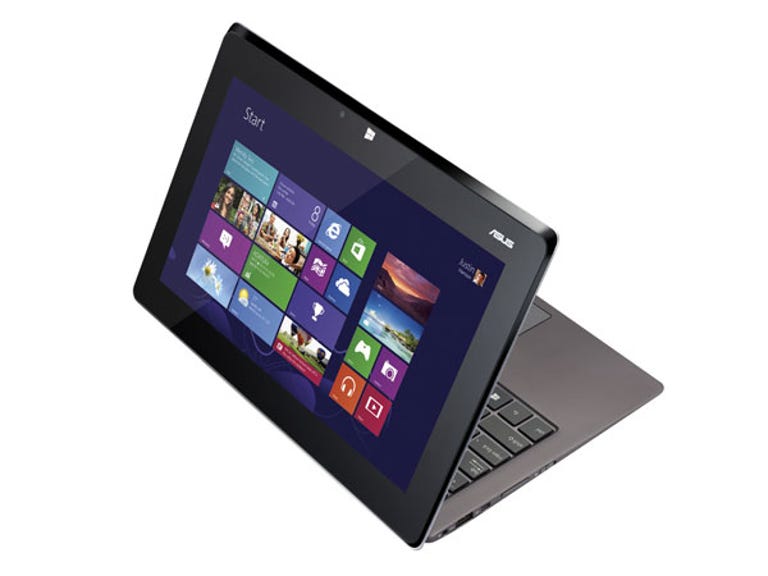 Why You Can Trust CNET
Why You Can Trust CNET Asus Taichi review: Asus Taichi
The Taichi is an experiment. While some may find a use for its dual screens, and it's built well enough, the lack of a touchscreen on the interior and troubling battery life could put even those people off.
We were a little hesitant when Asus announced the Taichi, a laptop with a screen on the front and the back of the lid. It was launched at the same time as an all-in-one where the screen could be detached as a giant tablet, so the experimental feeling of the event was running thick and heavy.
The Good
The Bad
The Bottom Line
Connectivity
- Touchscreen: yes
- USB 3.0: 2
- Video: micro HDMI, mini-DisplayPort (VGA via adapter)
- Ethernet: 100Mbps via USB 2.0 adapter
- Wireless: dual-band 802.11n, Bluetooth 4.0
We're still not sure now that it's in our hands. It could be feasibly useful for business types, who no longer have to rely on projectors — they can simply mirror what's on the first screen on the second.
Or, alternatively, it can act as an extended monitor, meaning that you can show unique content on each. Asus pitched this as "the kids can watch a movie while you do work", but we're hard pressed to come up with real uses for the functionality. Outside of having an impressive demonstration machine displaying an animation of, say, your company logo, it just seems impractical.
While by default the back screen becomes active when you close the lid, you can make the Taichi act like a normal laptop and sleep by flicking a hardware switch on the left-hand side. We did discover a bug with this: close the laptop lid, then re-open it, and the touch on the rear panel becomes enabled even though the screen is not, leading to some entertaining moments.
Practicalities aside, there's another issue with the Taichi: the interior screen isn't touch enabled, while the exterior is. This creates quite the cognitive dissonance — Windows 8 is a touch operating system, and we found ourselves uselessly pawing at the screen more than once. Eventually we trained ourselves that the interior wasn't a touchscreen, but it didn't make using the operating system any more bearable.
The 11.6-inch screens are fine, at 1080p and IPS each. The interior screen is a semi-gloss, while the exterior gets the full deal to make it better for touch, and to give a darker black when it's off. Despite the extra hardware, Asus has kept weight and height down, at 1.25kg and 17.4mm, respectively.
Asus has grafted an icon to the side of the charms bar, bringing up a Windows 8-themed control panel for the laptop. It's mostly useless, repurposing existing Windows functions, but you do get quick access to the ambient light-sensor settings, rotation lock, whether the screen locks or not when you close the lid and all of the aforementioned screen modes. The UI can also be accessed from a key on the keyboard, which cycles through the different monitor modes, with the user having to press Enter afterwards to commit.
The backlit keyboard and touch pad are nice to use, something that Asus has no doubt kept a watchful eye on since the initial ZenBook disaster.
Ports are fairly standard for the laptop size, offering two USB 3.0 ports, micro HDMI and a mini DisplayPort, along with a headset jack. Included in the package is a USB 2.0 to 100Mbps Ethernet adapter, a micro HDMI to VGA adapter and a carry pouch. Dual-band Wi-Fi and Bluetooth 4.0 make up the wireless side of the offering.
Our AU$1599 review SKU included a Core i5 3317U, 4GB of RAM and a 128GB SSD. Shell out AU$1899, and you'll get a 256GB SSD and Core i7 3517U. Considering the hardware here, Asus has done exceedingly well with the pricing, something that Acer could learn a thing or two from.
Application performance
Choose a benchmark: Handbrake | iTunes | Photoshop | Multimedia
Of the Windows 8 machines we've received so far, the Asus is the only Core i5 — so although it appears on the bottom of the charts here, its performance is actually quite fine.
Battery life
We've moved to a new battery test for Windows 8, a modified version of our heavy battery test for Windows 7. We loop a 720p video until battery depletion, with the screen brightness set to 40 per cent and the ambient brightness adjustment turned off.
While none of the Windows 8 laptops we've reviewed so far can be said to have amazing battery life, Asus' Taichi doesn't do well at all, and that's with only one screen active. Turn on the second, and of course things drop farther down.
Conclusion
The Taichi is an experiment. While some may find a use for its dual screens, and it's built well enough, the lack of a touchscreen on the interior and troubling battery life could put even those people off.
The Asus Taichi is expected to hit stores in Australia mid-November.


